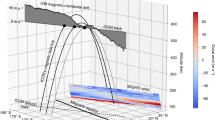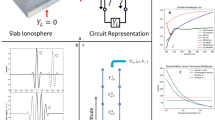Abstract
WE were interested to read the communication of Moffett and Hanson1 describing calculations of electron density distributions in the equatorial F-region of the ionosphere. Following our earlier work2, which treated the effect of electromagnetic drift as a perturbation only, we have also carried out calculations including a drift of arbitrary magnitude, in exactly the same way as Moffett and Hanson. Our results, which will be described in detail elsewhere, are almost identical to theirs, differing only in slight variations of the parameters. They show the main features of the daytime equatorial anomaly, including the approximate field-alignment, in the topside ionosphere only, of the latitudinal maxima of electron density at fixed heights.
This is a preview of subscription content, access via your institution
Access options
Subscribe to this journal
Receive 51 print issues and online access
$199.00 per year
only $3.90 per issue
Buy this article
- Purchase on Springer Link
- Instant access to full article PDF
Prices may be subject to local taxes which are calculated during checkout
Similar content being viewed by others
References
Moffett, R. J., and Hanson, W. B., Nature, 206, 705 (1965).
Bramley, E. N., and Peart, M., J. Geophys. Res., 69, 4609 (1964).
Maeda, H., Proc. Camb. Conf., Physical Society, 187 (1963).
Author information
Authors and Affiliations
Rights and permissions
About this article
Cite this article
BRAMLEY, E., PEART, M. Effect of Ionization Transport on the Equatorial F-Region. Nature 206, 1245–1246 (1965). https://doi.org/10.1038/2061245a0
Issue Date:
DOI: https://doi.org/10.1038/2061245a0
This article is cited by
-
The Appleton Anomaly
Nature (1965)
Comments
By submitting a comment you agree to abide by our Terms and Community Guidelines. If you find something abusive or that does not comply with our terms or guidelines please flag it as inappropriate.



